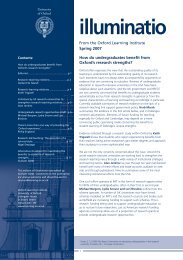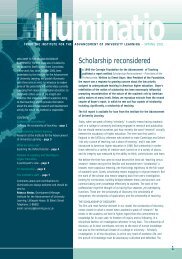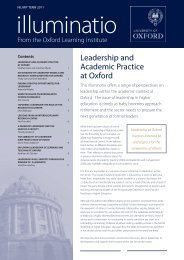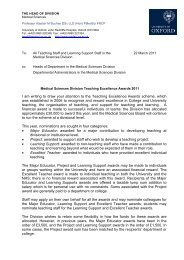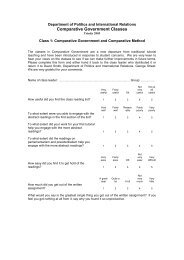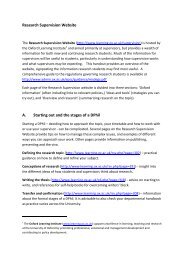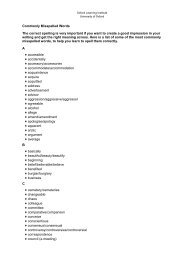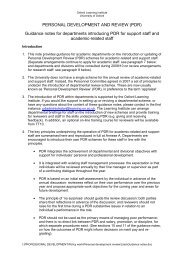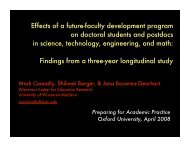Developing the whole student - Oxford Learning Institute - University ...
Developing the whole student - Oxford Learning Institute - University ...
Developing the whole student - Oxford Learning Institute - University ...
You also want an ePaper? Increase the reach of your titles
YUMPU automatically turns print PDFs into web optimized ePapers that Google loves.
Stimulus paper by Kathleen M. Quinlan 14<br />
The co-curriculum is concerned with creating intersections between living and learning, for<br />
example by encouraging <strong>student</strong>s to engage in extra-curricular activities that connect and<br />
extend <strong>the</strong>ir classroom learning 80 . O<strong>the</strong>r authors 81 have also found out-of-class experiences<br />
(such as interactions with peers and leadership opportunities) to be important contributors<br />
to <strong>student</strong> growth.<br />
Finally, Braskamp’s 82 campuses emphasised creating communities among various<br />
constituents of <strong>the</strong> university and between <strong>the</strong> university and its larger contexts. Such<br />
campuses had considered what it means to be a community and participants spoke about<br />
it as an ‘embodiment’ of <strong>the</strong> campus. Student breakfasts with <strong>the</strong> president, involving<br />
<strong>student</strong>s in campus governance 83 and involving staff in <strong>the</strong> educational experience 84 are all<br />
examples of promoting a sense of community.<br />
Colby et al 85 also emphasise <strong>the</strong> importance of intentionality in creating a culture,<br />
curriculum, co-curriculum and community, although <strong>the</strong>y do not explicitly use this ‘4C’s’<br />
conceptual framework. They studied 12 diverse American universities with successful<br />
programmes of moral and civic responsibility. While Braskamp’s campuses were all faithbased,<br />
only four out of Colby’s 12 campuses were. Fur<strong>the</strong>rmore, while all of Braskamp’s<br />
campuses were liberal arts colleges (1,800 to 6,500 <strong>student</strong>s), Colby’s sample includes a<br />
range of institutional types and sizes from 650 to more than 20,000 <strong>student</strong>s. Colby et al<br />
found that across <strong>the</strong> institutions studied, leaders at <strong>the</strong> highest level made ‘intentional<br />
efforts’ including serving as champions for, dedicating resources to and enacting a variety<br />
of strategies to create and support a university-wide culture around a particular set of<br />
shared values 86 . Thus <strong>the</strong>ir efforts went not simply on promoting particular curricula, but on<br />
emphasising <strong>the</strong> values that underlie certain teaching approaches. <strong>Learning</strong> outcomes and<br />
curricular and co-curricular reform were <strong>the</strong>n based upon <strong>the</strong>se shared values. While <strong>the</strong>re<br />
were common <strong>the</strong>mes across <strong>the</strong> 12 universities in <strong>the</strong> values <strong>the</strong>y embraced, institutions<br />
expressed <strong>the</strong>ir missions in unique terms, reflecting <strong>the</strong>ir own particular context. O<strong>the</strong>r<br />
studies also support <strong>the</strong> importance of reviewing and making explicit <strong>the</strong> university’s core<br />
values 87 and creating a distinctive mission and character 88 . In <strong>the</strong> third key study, <strong>the</strong> King’s<br />
Warwick Project 89 reports on a large project analysing <strong>the</strong> curricular innovation process<br />
at more than 20 research universities in five countries, through which <strong>the</strong>y highlight a<br />
number of points related to leadership. First, it is important that leaders articulate a clear<br />
agenda with consistent messaging. Leaders must be strong champions for a chosen<br />
strategic direction 90 . The agenda and messaging also need to be backed up with rewards,<br />
such as teaching relief, small implementation grants or alignment in promotion and tenure<br />
decisions. Rewards are not enough, however: leaders must find reasons why departments<br />
would want to engage with <strong>the</strong> initiative. There were a number of drivers of change<br />
identified across <strong>the</strong>ir study, including financial pressures, <strong>student</strong> learning, government<br />
mandates or a focus on graduate attributes 91 . Leaders need to be able to communicate<br />
how <strong>the</strong>ir agendas support departmental concerns and address larger drivers of change.<br />
Relatedly, leaders in central administration must respect departmental autonomy, allowing<br />
and encouraging departments to determine what <strong>the</strong> initiative might look like in <strong>the</strong>ir own<br />
discipline 92 . In most cases, <strong>the</strong> innovations were part of <strong>the</strong> vice-chancellor’s mission and<br />
vision, while a pro-vice-Chancellor actually led <strong>the</strong> initiative 93 . Typically, <strong>the</strong> major players<br />
had experience with curricular change at a lower level, such as a department, faculty or<br />
school. Building a consensus and a vision was important across <strong>the</strong> university, including<br />
collaboration with <strong>student</strong> unions. Although all of <strong>the</strong> universities met a set of predetermined<br />
inclusion criteria, each had a unique institutional context that was important to<br />
<strong>the</strong> process; appreciating that context was vital to success 94 .<br />
80<br />
Ashlock (1996)<br />
81<br />
Kuh (1995)<br />
82<br />
Braskamp et al (2006)<br />
83<br />
Boland (2005)<br />
84<br />
Eubanks and Lynch (2005)<br />
85<br />
Colby, Ehrlich et al (2003)<br />
86<br />
Colby, Ehrlich et al (2003)<br />
87<br />
Arthur (2005)<br />
88<br />
Glenn (2005), Shipley (1996)<br />
89<br />
Blackmore and Kandiko (2010)<br />
90<br />
Fujita (1994)<br />
91<br />
Brandes and Stuber (2004)<br />
92<br />
Larrey and Larry (1999)<br />
93<br />
Gamsky and Oleshansky (1980)<br />
94<br />
Newsome (1997), Braskamp,<br />
Trautvetter et al (2008)



